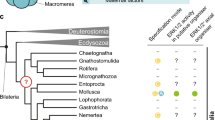Abstract
ACTIVIN, a peptide growth factor related to tumour growth factor-β, has been implicated in early inductive interactions in vertebrates1–4 and can induce Xenopus blastula ectodermal explants to develop a rudimentary axial pattern with anteroposterior and dorsoventral polarity4,5. Here we demonstrate that prospective dorsal and ventral regions of the ectoderm respond differently to the same concentration of activin. Thus, activin does not seem to endow ectodermal cells with polarity but rather reveals a pre-existent pattern. Our results suggest that patterning of mesoderm is determined not only by a localized inducer, but also by the differential competence of cells in the responding tissue.
This is a preview of subscription content, access via your institution
Access options
Subscribe to this journal
Receive 51 print issues and online access
$199.00 per year
only $3.90 per issue
Buy this article
- Purchase on Springer Link
- Instant access to full article PDF
Prices may be subject to local taxes which are calculated during checkout
Similar content being viewed by others
References
Asashima, M. et al. Roux's Arch. devl Biol. 198, 330–335 (1990).
Smith, J. C., Prkce, B. M. J., Van Nimmen, K. & Huylebroeck, D. Nature 345, 729–731 (1990).
van den Eijnden-Van Raaij, A. J. M. et al. Nature 345, 732–734 (1990).
Thomsen, G. T. et al. Cell 63, 485–493 (1990).
Sokol, S., Wong, G. G. & Melton, D. A. Science 249, 561–564 (1990).
Nieuwkoop, P. D. Roux's Arch. devl Biol. 163, 298–315 (1969).
Spemann, H. Embryonic Development and Induction (Yale University Press, New Haven, 1938).
Nakamura, O. in A Milestone of a Half-century from Spemann. (eds Nakamura, O. & Toivonen, S.) 179–220 (Elsevier/North Holland Biomedical, Amsterdam, 1978).
Dale, L. & Slack, J. Development 100, 279–295 (1977).
Scharf, S. & Gerhart, J. C. Devl Biol. 79, 181–198 (1980).
Gimlich, R. L. & Gerhart, J. C. Devl Biol. 104, 117–130 (1984).
Green, J. B. A. & Smith, J. C. Nature 347, 391–394 (1990).
London, C., Akers, R. & Phillips, C. Devl Biol. 129, 380–389 (1988).
Savage, R. & Phillips, C. R. Devl Biol. 133, 157–168 (1989).
Sharpe, C. R., Fritz, A., De Robertis, E. M. & Gurdon, J. B. Cell 50, 749–758 (1987).
Dixon, J. E. & Kintner, C. Development 106, 749–757 (1989).
Mitrani, E. et al. Cell 63, 495–501 (1990).
Ruiz i Altaba, A. & Jessel T. Genes Dev. 5, 175–187 (1991).
Newport, J. & Kirschner, M. Cell 30, 687–696 (1982).
Nieuwkoop, P. & Faber, J. Normal Table of Xenopus laevis (Daudin), (North-Holland, Amsterdam, 1967).
Author information
Authors and Affiliations
Rights and permissions
About this article
Cite this article
Sokol, S., Melton, D. Pre-existent pattern in Xenopus animal pole cells revealed by induction with activin. Nature 351, 409–411 (1991). https://doi.org/10.1038/351409a0
Received:
Accepted:
Issue Date:
DOI: https://doi.org/10.1038/351409a0
This article is cited by
-
Molecular specification of germ layers in vertebrate embryos
Cellular and Molecular Life Sciences (2016)
-
Antero-posterior tissue polarity links mesoderm convergent extension to axial patterning
Nature (2004)
-
Initial patterning of the central nervous system: How many organizers?
Nature Reviews Neuroscience (2001)
-
Effects of inhibin on activin A-Induced glucose metabolism in rat hepatocytes
Endocrine (1996)
-
Production of activin a in human intestinal epithelial cell line
Digestive Diseases and Sciences (1995)
Comments
By submitting a comment you agree to abide by our Terms and Community Guidelines. If you find something abusive or that does not comply with our terms or guidelines please flag it as inappropriate.



